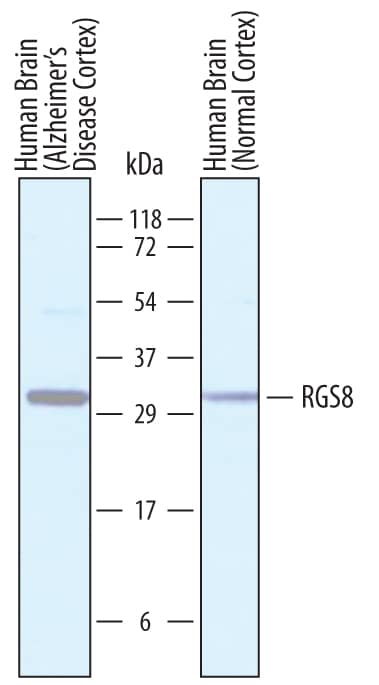Human RGS8 Antibody
R&D Systems, part of Bio-Techne | Catalog # AF6880

Key Product Details
Species Reactivity
Applications
Label
Antibody Source
Product Specifications
Immunogen
Asn10-Thr76
Accession # P57771
Specificity
Clonality
Host
Isotype
Scientific Data Images for Human RGS8 Antibody
Detection of Human RGS8 by Western Blot.
Western blot shows lysates of human brain (Alzheimer's disease cortex) tissue and human brain (normal cortex) tissue. PVDF membrane was probed with 1 µg/mL of Sheep Anti-Human RGS8 Antigen Affinity-purified Polyclonal Antibody (Catalog # AF6880) followed by HRP-conjugated Anti-Sheep IgG Secondary Antibody (Catalog # HAF016). A specific band was detected for RGS8 at approximately 30 kDa (as indicated). This experiment was conducted under reducing conditions and using Immunoblot Buffer Group 8.RGS8 in Human Brain.
RGS8 was detected in immersion fixed paraffin-embedded sections of human brain (cerebellum) using Sheep Anti-Human RGS8 Antigen Affinity-purified Polyclonal Antibody (Catalog # AF6880) at 3 µg/mL overnight at 4 °C. Tissue was stained using the Anti-Sheep HRP-DAB Cell & Tissue Staining Kit (brown; Catalog # CTS019) and counterstained with hematoxylin (blue). Specific staining was localized to Purkinje neurons. View our protocol for Chromogenic IHC Staining of Paraffin-embedded Tissue Sections.Applications for Human RGS8 Antibody
Immunohistochemistry
Sample: Immersion fixed paraffin-embedded sections of human brain (cerebellum)
Western Blot
Sample: Human brain (Alzheimer's disease cortex) tissue and human brain (normal cortex) tissue
Formulation, Preparation, and Storage
Purification
Reconstitution
Formulation
Shipping
Stability & Storage
- 12 months from date of receipt, -20 to -70 °C as supplied.
- 1 month, 2 to 8 °C under sterile conditions after reconstitution.
- 6 months, -20 to -70 °C under sterile conditions after reconstitution.
Background: RGS8
RGS8 (Regulator of G-protein signaling 8) is a 22-23 kDa (predicted) member of the B/R4 subfamily, RGS family of proteins. It is expressed in NK cells and neurons, particularly cerebellar Purkinje cells, and is known to regulate GPCR signaling. When GPCRs are activated, a GPCR cytoplasmic domain associated G alpha beta gamma heterotrimer dissociates in response to GTP binding. This generates G alpha:GTP and G beta gamma dimers that initiate downstream signaling. G alpha has GTPase activity, and when GTP is hydrolyzed, the G alpha beta gamma trimer reforms and stops signaling. RGS8 potentiates G alpha GTP hydrolase activity, particularly when associated with M1 muscarinic acetylcholine receptors. Human RGS8 is 180 amino acids (aa) in length, and is characterized by the presence of one RGS domain (aa 56-171), and an N-terminal GPCR binding motif (aa 6-9). There is one splice variant that shows a 27 aa substitution for aa 1-9. Expression of this variant may negatively impact its regulation of G alpha-coupled responses. Over aa 10-76, human RGS8 shares 98% aa identity with mouse RGS8.
Long Name
Alternate Names
Gene Symbol
UniProt
Additional RGS8 Products
Product Documents for Human RGS8 Antibody
Product Specific Notices for Human RGS8 Antibody
For research use only

